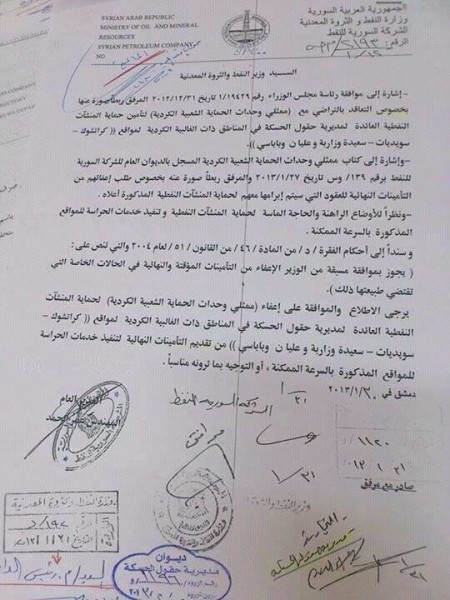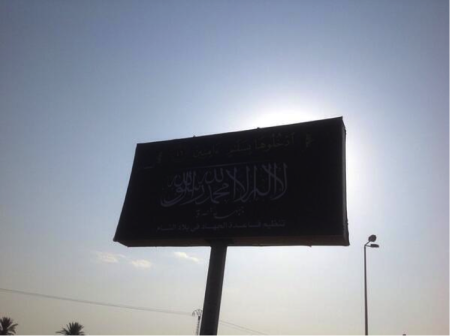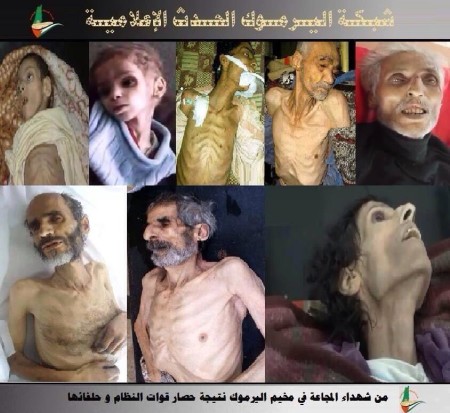“Inter-Rebel Fighting Enters a New Phase as Salafists Declare Open War on ISIS,” by Daniel Abdallah
Posted by Joshua on Friday, February 14th, 2014
Inter-Rebel Fighting Enters a New Phase as Salafists Declare Open War on ISIS
by Daniel Abdallah
for Syria Comment, February 14, 2014
Three days ago, the inter-rebel fighting entered a new phase. For the first time, Salafist factions have openly publicised their attack on the Islamic State of Iraq and Sham and the feircest battles have moved from the Northwest to the East of Syria. Ahrar ash-Sham (AS) and Jabhat an-Nusra (JN) – al-Qaeda’s official branch in Syria – are officially at war with ISIS. The recent fighting spans many governorates, but two – Deir az-Zour and al-Hasakah – have seen the most intense fighting between ISIS and JN/AS. Concurrent attacks on ISIS have taken place in rural Aleppo and Raqqa on a smaller scale, perhaps to take advantage of ISIS’s vulnerability because it was preoccupied in the East.
Although there were previous direct engagements between AS and JN, on the one hand, and ISIS, on the other, they were never at such scale, never so exacerbated, at least, as will be shortly explained, from the AS and JN side. The most well-known precedent took place in the days leading to 12th January 2014 – the date on which Raqqa fell into the sole control of ISIS. ISIS had been surrounded in the gubernatorial palace by AS from the West and by JN from the East, and the outcome of the battle looked all but certain. Quite unexpectedly, JN fighters were informed on their radios by ISIS to ‘surrender or withdraw because AS have left the battle field and you are on your own’.[1] For ideological reasons, AS fighters had decided not to participate in the fitna (civil discord among Muslims) and to avoid having the blood of their ‘brothers’ on their hands. They, however, were not rewarded for their attempt to remain neutral. They were captured and executed by a different ISIS force outside Raqqa, although ISIS had initially agreed to grant them safe passage.[2]
The infighting under discussion had its origin in a dispute over the control of the Konicko oil field in Khasham, Deir az-Zour. Cottage-industry methods of refining crude oil have become a profitable source of cash for rebels and tribesmen alike in the ‘liberated’ areas of North Eastern Syria.[3] The oil field was originally under the control of tribes who had pledged allegiance to ISIS, but the Common Islamic Court (Hay’a Shari’a) in Deir az-Zour – largely under the influence of JN, as they readily admit – decided to unseat those tribes and put the field under its direct control on 14th November 2014. ‘It is unacceptable that a small group should be allowed to control the common wealth of the Umma [the wider Islamic society], and in such an unorganised manner that led to electricity being cut off for many days leading to the death of innocent children and the spoilage of food and medical supplies’, it cited as reasons.[4] On 2nd February 2014 the Bu Jamel and the Bakeer tribes – allied with JN and ISIS respectively – entered into a row that resulted in ISIS retaking control of the field, and a few other facilities.[5] On 7th February, JN issued a statement intended as a stern warning to ISIS and as comment on what happened.[6] ‘ISIS has shocked us by taking control of some vital facilities in Dair az-Zour, which were under the control of the Hay’a Shari’a […] cutting supply routes to the soldiers of Islam who are standing at the frontlines inside the city and, at the same time, separating them from their strategic depth in the Deir az-Zour governorate’, they claimed. For ‘strategic depth’, read “disturbing cash flow” – the Konicko field, under rebel control, has been reported to generate $330,000 a day.[7] They further say that, once the field was in their hands, they had to give a cut to the local ISIS commander because, he insisted, he had ‘intended to liberate it’ before JN. Although JN admits the guards they had put in charge of Konicko had defected to ISIS, they say this does not give ISIS the right to retake it. JN relate that such actions are to be expected from people like ISIS, their commander had, after all, stolen $5 million from JN. JN, then, find no other way to describe ISIS’ actions than baghi (injustice), which Islamic theology allows retaliation to. ‘Either give back what you have wrongfully taken to those to whom it belongs’ or, stand warned, we have men who are ready to ‘counter your aggression and stop your injustice’.[8]
JN’s threats appeared credible. On the next day (8th February), they started shelling ISIS positions all over Deir az-Zour, the reports also mentioned that AS and other factions were collaborating with JN in this effort.[9] JN put ISIS’ biggest headquarters in Deir az-Zour – their centre near the salt mines of at-Tibni – under siege.[10] A scholar in JN tweeted that ‘there is only slaughter for those transgressors [ISIS]’.[11] One time JN enemies, the Busaraya local clan from the Masrab village joined the fight on JN’s side.[12] JN, however, said that no men from Masrab were fighting with it.[13] By the end of the day, JN and the Islamic Front (of which AS are members) had overtaken al-Bukamal on the Iraqi border,[14] and could count the ISIS military commander in Deir az-Zour – Abu Dujana the Libyan – among the casualties.[15]
According to Aaron Zelin’s analysis, during the first stage of the infighting ISIS was able to reconquer most of the territory it was almost driven out of and exercise sole control over it by, among other things, securing localised ceasefires and, while exploiting this and the hesitation of Salafist factions to fight them, thereby allocating resources where they were most needed.[16] ISIS may have tried to use the same tactic in this phase but, so far, its efforts appear to have been unsuccessful. They were able to secure a ceasefire with JN in Mouhasen,[17] and there were reports that they had called for reinforcements from Raqqa and Aleppo.[18]
The second day of fighting witnessed considerable escalation, ISIS detonated a car packed with explosives in the oil market in Sabha.[19] The car set off from the Jafra oil field, which ISIS controlled, and was reportedly headed to a JN checkpoint in al-Busaira. However, it was stopped in as-Sabha by one of the market guards. The guard asked the driver to get out of the car but he told him he was a suicide bomber and asked him to let him pass as this was not the area he wanted to blow up. The guard attempted to force him to get out of the car, but the suicide bomber ended up detonating the explosives killing 22 people, six of whom were children.[20] In a different incident, JN was reported to have executed 20 ISIS members.[21]
The same day (9th February) ISIS issued a statement about the events in Deir az-Zour.[22] It said JN had wronged ISIS before: by not joining ISIS when it was formed, by collaborating with Sahawat (a pejorative reference to AS) against it in Raqqa and, now, by seeking ‘revenge’ on ISIS whose peaceful efforts to ‘correct the path of Sahawat and counter their aggression’, ‘being careful not to spill any blood’ had caused, so ISIS claimed, many JN fighter to defect and join ISIS.[23] It also explained that JN were now collaborating with “Sahawat” again in this fight, which include: Liwa al-Ahwaz, AS and Liwa Ja’far at-Tayyar (part, with AS, of the Islamic Front), and with the ‘criminals of the Masrab village’. It identified the ISIS positions which had been shelled and fired upon with tanks by JN and its allies as: at-Tibni, Ma’dan, Mintaqat al-Jadeed and al-Jafra – where JN had reportedly executed 20 ISIS members. The statement ended with a threat.
ISIS, the next day (10th February), withdrew from all their positions in Deir az-Zour,[24] except for their centre at the Tibni salt mines.[25] Casualty reports in the ISIS camp ranged from 20 to 50.[26] The day also witnessed JN blowing up the ISIS communication centre in Deir az-Zour.[27]
While JN, AS et al where enjoying these tactical advances on ISIS in Deir az-Zour; concurrently, it was ISIS who was on the advance, against these very same groups, in al-Hasaka. A local media activists informs me that there had been a tactical alliance between all these factions when they were fighting the YPG in rural Hasaka – the alliance had even been codified into an ‘official’ agreement between ISIS and AS, as will be shortly explained.[28] Once they had been able to drive the YPG out of Tal Barak and Tal Hamees, however, ISIS turned on its allies forcing many, according to the AS narrative, to pledge allegiance to it. By 9th February, ISIS had emerged as the sole power in Tal Barak, Tal Hamees and al-Hool in rural Hasaka.[29] Both AS and JN released statements about the events in rural al-Hasaka. AS claimed that they have a recording in which ISIS scholars deem AS members infidels (kuffar) because they are ‘in league with other infidels since they refrain from publicly showing any animosity toward them’.[30] This is a reference to the West and to regional powers all of whom ISIS considers infidels. They said they were going to release the recording later. According to the statement, on 6th February ISIS took a ‘treacherous stab’ at AS – attacking AS centres all over Hasaka, stealing money and weapons, and capturing fighters and forcing them to pledge allegiance to ISIS. All this happened despite an earlier official agreement between the two parties ‘not to fight and to concentrate on fighting the regime and its allies in the area’. The agreement opened with the phrase: ‘we swear to Allah the Great that we shall not raise our arms in the face of our brothers or each other or any factions that fight the regime’. For the above reasons AS considers that agreement null and void and that the ISIS are a ‘treacherous and betraying group’. The JN statement talks of ISIS capturing JN fighters in Shaddadi, al-Hasaka and killing their soldier Abu Ishaak al-Mashhadani, in ‘cold blood’.
During the same period, perhaps to take advantage of ISIS involvement in the East, there were sporadic attacks on it in the Northern West. In Tal Abiadh, Jabhat Tahreer al-Furat al-Islamiya managed to capture 3 ISIS fighters, for example.[31] In ar-Raqqa, there were reports of an AS suicide bomber detonating himself in an ISIS stronghold killing 11 ISIS members, although the report is of questionable accuracy.[32] ISIS was also engaged in al-Ula and Tal Shheer in rural Aleppo[33], and the result was al-Ula slipping out of its hands.[34] A local contact in Jarablus (Northern rural Aleppo) informed me that the ISIS contingent stationed there had partially blown up the bridge, over the Euphrates, connecting Jarablus with ash-Shuyoukh and Ain al-Arab further to the East, to fend off an imminent attack by brigades loyal to Liwa’ al-Tawheed (part of the Islamic Front).[35] He sent this photo in which one can see the damaged Western end of the bridge:
ISIS has now been expelled from one the most economically important regions (because of the oil) for the armed groups, which might impact it in a too insignificant way. Can this stage be read as a prelude to a wider engagement between JN and AS and ISIS? For JN, AS and the Islamic Front in general fighting ISIS in Deir az-Zour has been an epiphenomenon brought about by local conditions, rather than a key concern grounded in a central strategy. Similar conditions exist in Hasaka, but unless these groups are able to mobilise a sufficient force to counter ISIS locally, it is unlikely that they would move contingents from the much more important region of Deir az-Zour. The presence of the YPG might be an important local factor forcing unity, however uneasy, and working to preclude the possibility of wider conflict à la Deir az-Zour. Conditions that could allow for the justification of escalation in Raqqa, on the one hand, and the will to mobilise a force large enough to do so by JN and the IF, on the other, are lacking. The strategy used by ISIS’ ideological siblings (AS and JN) to justify attacks on it has been centred around using local grievances caused by ISIS, that are fresh in memory, and frame their attacks as fights for justice – not, and this is important, as attempts to defeat ISIS or cause it to cease to exist as such. This framework currently remains inapplicable to Raqqa, which is, also, much less economically significant than Deir az-Zour or Hasaka. There is a moderate possibility for further escalation in rural Aleppo, because the region is under a much more heterogeneous form of control and different factions, with different loyalties, co-exist in close proximity to one another.
Could ISIS retaliate and regain its positions in Deir az-Zour? As noted above, in the first stage of the infighting, ISIS was able to make advances by capitalising on local ceasefires to divert resources to the front lines. In this stage, such possibilities seem to have been exhausted. Retaking Deir az-Zour, now, requires ISIS to gather troops from its strongholds such as Raqqa or Eastern rural Aleppo, leaving these areas vulnerable to local take overs. Although this is an embarrassing defeat for ISIS, fighting all other militias combined in Deir az-Zour may turn into a significant threat to its ability to control large territories. They might opt out, instead, for small scale operations, sabotage and suicide bombings to destabilise the area for the other factions, and try to frame this as a tactical victory.
What about Assad? Assad is still capable of marketing himself as a potential partner in fighting ‘terrorism’, for although the rebels are attacking ISIS, something he is not doing, they are in close cooperation with JN – al-Qaeda’s official branch, which the US deems a terrorist organisation.
The overall situation in the inter-rebel war is highly atomised, with a mixture of small scale victories and losses throughout the country. This characterisation is likely to remain true, as not only the infighting between the rebels but the Syrian Civil War in general have proven to be governed by reverse hierarchies of conditions where the local governs the global, rather than the other way around.
[1] http://www.alquds.co.uk/?p=129140; http://www.aljazeera.net/mob/f6451603-4dff-4ca1-9c10-122741d17432/4b69f803-8b50-46c9-8bdb-ef877836f535
[3] http://www.reuters.com/article/2013/05/10/syria-crisis-oil-tribes-idUSL6N0DQ1MG20130510; http://carnegieendowment.org/syriaincrisis/?fa=54131
[4] https://twitter.com/JehadNews/statuses/432105631387254784. Also see http://www.inewsarabia.com/485/%D8%A3%D8%B3%D8%A8%D8%A7%D8%A8-%D8%B3%D9%8A%D8%B7%D8%B1%D8%A9-%D8%A7%D9%84%D9%87%D9%8A%D8%A6%D8%A9-%D8%A7%D9%84%D8%B4%D8%B1%D8%B9%D9%8A%D8%A9-%D8%A8%D8%AF%D9%8A%D8%B1-%D8%A7%D9%84%D8%B2%D9%88%D8%B1-%D8%B9%D9%84%D9%89-%D9%85%D8%B9%D9%85%D9%84-%D8%BA%D8%A7%D8%B2-%D9%83%D9%88%D9%86%D9%88%D9%83%D9%88.htm
[7] http://www.inewsarabia.com/485/%D8%A3%D8%B3%D8%A8%D8%A7%D8%A8-%D8%B3%D9%8A%D8%B7%D8%B1%D8%A9-%D8%A7%D9%84%D9%87%D9%8A%D8%A6%D8%A9-%D8%A7%D9%84%D8%B4%D8%B1%D8%B9%D9%8A%D8%A9-%D8%A8%D8%AF%D9%8A%D8%B1-%D8%A7%D9%84%D8%B2%D9%88%D8%B1-%D8%B9%D9%84%D9%89-%D9%85%D8%B9%D9%85%D9%84-%D8%BA%D8%A7%D8%B2-%D9%83%D9%88%D9%86%D9%88%D9%83%D9%88.htm
[12] https://twitter.com/foor_ss/statuses/432204414024441856; https://twitter.com/shamy_greb/statuses/432201678453223424
[19] https://www.facebook.com/albssyra/posts/557837927646611 WARNING: GRAPHIC CONTENT.
[20] https://www.facebook.com/photo.php?fbid=824931797522053&set=a.810361215645778.1073741828.757970244218209&type=1
[21] https://twitter.com/search?q=%23%D8%A7%D9%84%D9%86%D8%B5%D8%B1%D8%A9_%D9%88%D9%84%D8%AD%D8%B1_%D9%8A%D8%B9%D8%AF%D9%85%D9%88%D9%86_%D8%B9%D8%B4%D8%B1%D9%8A%D9%86_%D9%85%D9%86_%D8%AC%D9%86%D9%88%D8%AF_%D8%A7%D9%84%D8%AF%D9%88%D9%84%D8%A9&src=hash
[23] Jabhat an-Nusra was originally an unofficial branch of the Islamic State in Iraq. After a while, Baghdadi – leader of the ISI – annulled JN and declared the creation of the ISIS. Jawlani – leader of JN – did not accept, said he was not consulted and appealed to the authority of Ayman az-Zawahiri – head of Al-Qaeda Central, who ruled in his favour. It recently turned out, however, that neither the ISI, nor the ISIS, were under the authority of Zawahiri as they were not part of al-Qaeda.
The Sahwa (awakening) movement started in Iraq when local tribes collaborated with the US army to fight al-Qaeda. ISIS uses the term pejoratively to refer to groups who fight it.
[24] https://twitter.com/syrianewsco/statuses/432816624924893184; https://twitter.com/JehadNews/statuses/432794611648831489.
[26] Ibid. For the higher number see: https://twitter.com/anassherzad/status/432864537130201090
[28] The YPG (Yekîneyên Parastina Gel, the People’s Protection Units) are a largely Kurdish group that is considered to be the armed wing of the Kurdish Democratic Union Party (although they deny this). They have been clashing with different rebel factions in an attempt to keep Kurdish-majority areas neutral and to establish a nascent order as the basis of a future federal, some would say independent, Kurdish region in North-eastern Syria.
[35] He gave the names of the specific brigades as: Ahrar al-Qubba (Tawheed), Ansar ash-Sharia (Liwa’ al-Islam), ash-Shaheed Juma’a al-Jader (Tawheed), and ath-Thaher Beibars (Tawheed). They are all part of the Islamic Front.



 Aftermath of car bomb in Hebzollah stronghold, January 2014. Photograph: AFP/Getty Images
Aftermath of car bomb in Hebzollah stronghold, January 2014. Photograph: AFP/Getty Images






















 The Syrian opposition Coalition
The Syrian opposition Coalition 





